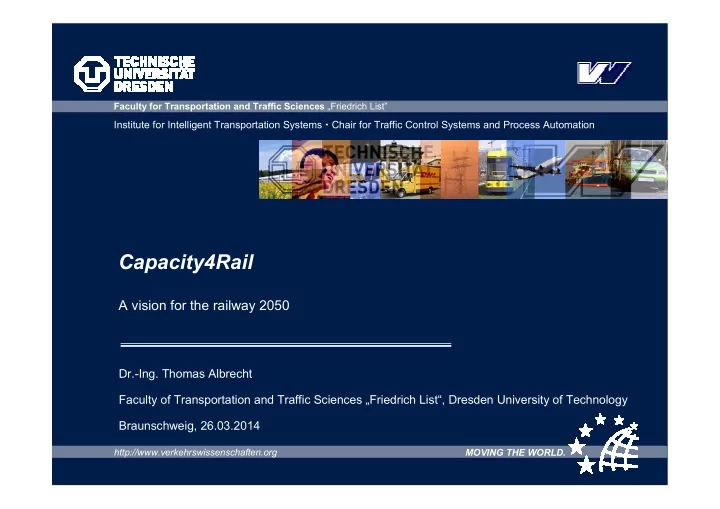

Faculty for Transportation and Traffic Sciences „Friedrich List” Institute for Intelligent Transportation Systems � Chair for Traffic Control Systems and Process Automation Capacity4Rail A vision for the railway 2050 Dr.-Ing. Thomas Albrecht Faculty of Transportation and Traffic Sciences „Friedrich List“, Dresden University of Technology Braunschweig, 26.03.2014 http://www.verkehrswissenschaften.org MOVING THE WORLD.
Overall project summary • Consortium: – 48 partners (leader: UIC, several IM + RU+ Industry + Research) – 4 years project duration (2013-2017) • Five subprojects: – Infrastructure – Freight traffic – Operations – Monitoring – Migration INSTITUTE FOR INTELLIGENT TRANSPORTATION SYSTEMS Chair for Traffic Control Systems and Process Automation 2
Ca pa c ity fo r Ra il Optimal strategies to manage major disturbances Kick off meeting SP3, Paris – 17 october 2013 WP33 Thomas Albrecht Technische Universitaet Dresden, leader WP33
WP33 in general This WP will provide control and information strategies for real-time traffic management for future operations, i.e. how to operate trains so as to maximise capacity for passengers and freight at low carbon impact. A roadmap for an automatic application of these strategies will be developed. 4
Extreme weather and other hazards Source: theguardian.com Source: DB Mediathek Ash cloud problem in Air traffic Flood in Germany � Railway had difficulties in providing � It took a long time before reliable adequate replacement service replacement service was in operation 5
Objectives Main objective: Increase CAPACITY of European railway network • provide strategies for traffic management which increase the capacity of the network • derive joint requirements and testing for incident management plans, e.g. in extreme weather and other hazards • analyse and classify network topologies and traffic characteristics and thereby identify and characterise system bottlenecks and vulnerability of system elements • identify optimal strategies for resilient operations of the identified classes of system bottlenecks and traffic types and develop a roadmap for automation strategies in rail traffic management • specify requirements for reliable and cost effective collection of real-time data on train operations and delay monitoring • derive joint requirements and testing for incident management plans, e.g. in extreme weather and other hazards 6
Summing up New More freight Network/ infrastructure trains with new Traffic today (very high technology speed) Growing Operation? Operation? How to operate that? Traffic Incident Automation Management Management 7
Capacity increase through automation of operation Capacity 2020 e.g. Traffic Management (Dispatcher Support) +20% e.g. Driver e.g. Automated Today Advisory Driving Systems Level of automation of operation 8
What about railML in the project? (I) – Optimisation of operation requires data – Build on results of project ON-TIME: • Use of railML for modelling of infrastructure, timetable, rolling stock and interlocking for 4 different networks (UK, Sweden, Netherlands, Italy) • All optimisation tools of different partners use railML for static data (Graffica, NTT Data, Ansaldo, TU Delft, TU Dresden, IFSTTAR, Univ of Birmingham, …) • Applications: – Conflict detection and resolution – Driver Advisory Systems – Automatic route setting – Traffic state prediction – Timetabling INSTITUTE FOR INTELLIGENT TRANSPORTATION SYSTEMS Chair for Traffic Control Systems and Process Automation 9
What about railML in the project? (II) – Possible contributions to development of railML • Identified gaps for railway (e.g. traffic demand, operational rules) • Identified ambiguities (e.g. running resistance, visualization) • Multimodality (connections to other means of transport, e.g. relation to other standardisation approaches IDMVU, INSPIRE) • Dynamic data: How can dynamic data exchange build on the static data model? (Different proposals drafted and tested) INSTITUTE FOR INTELLIGENT TRANSPORTATION SYSTEMS Chair for Traffic Control Systems and Process Automation 10
Recommend
More recommend